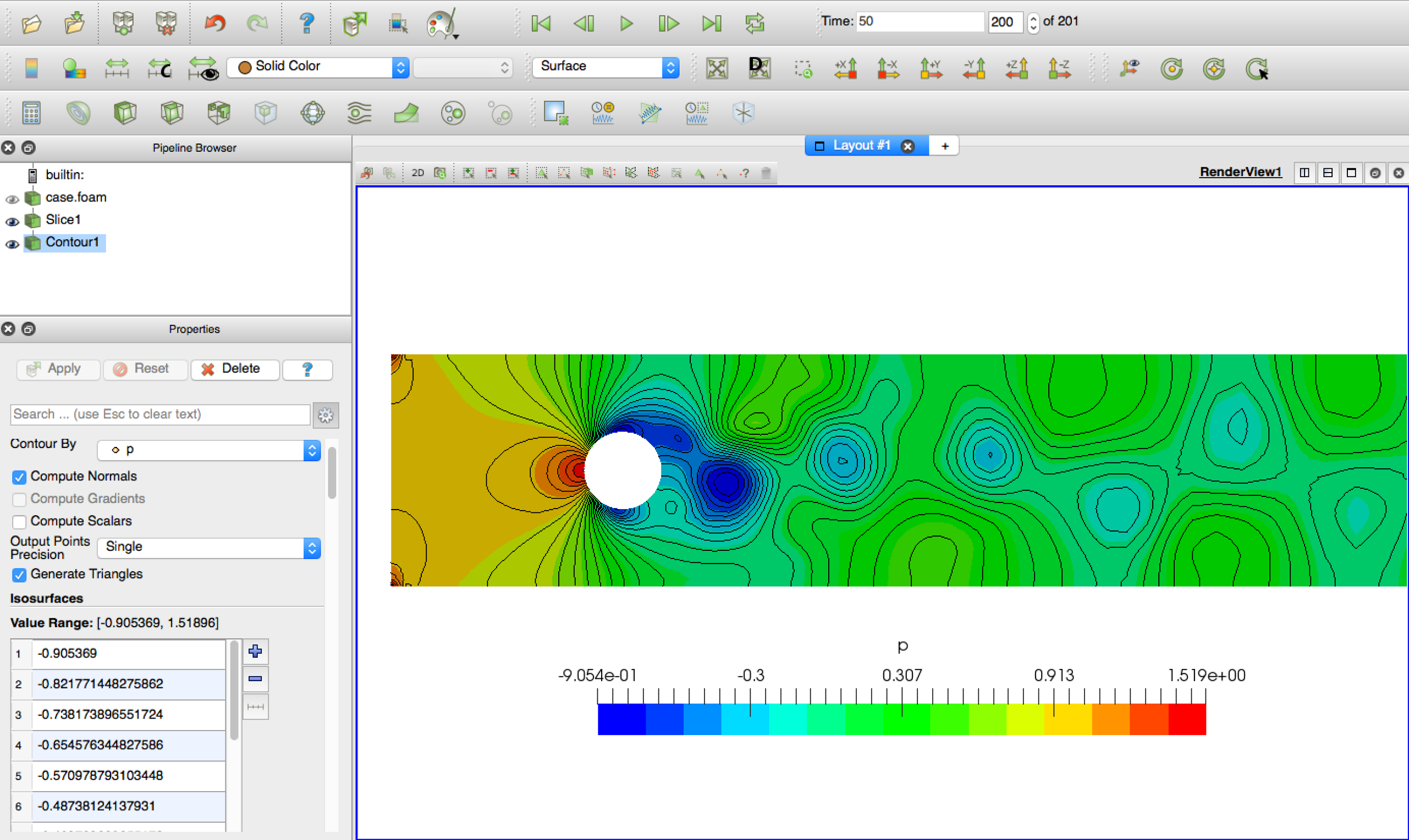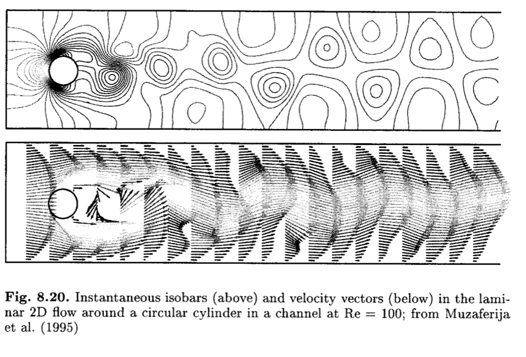My second tutorial: cylinderInChannel
You can find the files for this tutorial under tutorials/fluids/cylinderInChannel.
Tutorial Aims
- Demonstrate how to perform a fluid-only analysis in solids4foam;
- Explain how a solids4foam fluid case differs from a standard OpenFOAM fluid case.
Case Overview
This is the classic "flow over a cylinder in a channel" test case, as analysed by, for example, Ferziger and Peric (2002). The problem is modelled as 2-D. The inlet flow velocity profile is specified (coming in from the left), and the outlet (right) gauge pressure is zero. The upper wall, lower wall and cylinder are no-slip walls.
We assume an incompressible Newtonian isothermal laminar fluid, where the Navier-Stokes governing equations take the form:
\[\nabla \cdot \boldsymbol{v} = 0\] \[\frac{\partial \boldsymbol{v}}{\partial t} + \nabla \cdot (\boldsymbol{v}\boldsymbol{v}) = \nu \nabla^2 \boldsymbol{v} - \frac{1}{\rho} \nabla p + \boldsymbol{f_b}\]We will use the PIMPLE pressure-velocity coupling algorithm:
for all time-steps
do
solve momentum equation for U (terms depending on p are calculated explicitly)
solve pressure equation for p (terms depending on U are calculated explicitly)
while not converged
end
Expected Results
For Re = 100, the flow is expected to be unsteady, with vortices shedding from the cylinder.
Pressure contours (top) and velocity vectors (bottom) from Ferziger and Peric (2002)
Running the Case
The tutorial case can be run using the included Allrun script, i.e. > ./Allrun. In this case, the Allrun script is
#!/bin/bash
# Source tutorial clean functions
. $WM_PROJECT_DIR/bin/tools/RunFunctions
# Source solids4Foam scripts
source solids4FoamScripts.sh
# Check case version is correct
solids4Foam::convertCaseFormat .
# Create the mesh
solids4Foam::runApplication fluentMeshToFoam cylinderInChannel.msh
solids4Foam::runApplication changeDictionary
# Run the solver
solids4Foam::runApplication solids4Foam
# Create plots
if command -v gnuplot &> /dev/null
then
if [[ -f "./postProcessing/forces/0/forces.dat" ]]
then
echo "Generating force.pdf using gnuplot"
gnuplot force.of9.gnuplot &> /dev/null
else
echo "Generating force.pdf using gnuplot"
gnuplot force.gnuplot &> /dev/null
fi
else
echo "Please install gnuplot if you would like to generate the plots"
fi
where the solids4Foam::convertCaseFormat . script makes minor changes to the case to make it compatible with your version of OpenFOAM/foam-extend. As can be seen, the mesh in the fluent format is converted to the OpenFOAM format before running the solids4Foam solver. After the solver has finished, a force.pdf plot is generated if the gnuplot program is installed.
Remember that a tutorial case can be cleaned and reset using the included Allrun script, i.e. ./Allclean.
Analysing the Results
In the ParaView, a von Kármán vortex street is clearly visible by viewing the pressure field p:

Delving Deeper
If you would like to learn more about the case, then please continue; if not, how about you check out another tutorial.
Case Structure
The case follows the typical pimpleFoam (or pimpleDyMFoam) case structure:
cylinderInChannel
├── 0
│ ├── U
│ └── p
├── Allclean
├── Allrun
├── constant
│ ├── RASProperties
│ ├── dynamicMeshDict
│ ├── fluidProperties
│ ├── physicsProperties
│ ├── polyMesh
│ │ └── …
│ ├── transportProperties
│ └── turbulenceProperties
├── cylinderInChannel.msh
└── system
├── changeDictionaryDict
├── controlDict
├── fvSchemes
└── fvSolution
The only difference with a pimpleFoam case is that a constant/physicsProperties dictionary must be present, where the type of analysis is specified:
type fluid;
//type solid;
//type fluidSolidInteraction;
In addition, as this is a "fluid" analysis, a constant/fluidProperties dictionary must also be present, where the PIMPLE algorithm for an incompressible isothermal fluid is specified:
fluidModel pimpleFluid;
pimpleFluidCoeffs
{}
The pimpleFluid fluid model does not require any settings to be specified. Parameters related to the PIMPLE algorithm as instead specified in system/fvSolution, just like for the pimpleFoam solver.
Apart from specifying the physicsProperties and fluidProperties dictionaries, the case is equivalent to a standard pimpleFOAM case, e.g. in terms of transportProperties, RASProperties, dynamicMeshDict, U, p, fvSchemes, etc.
Code: fluidModel
For the cylinderInChannel test case, we have selected a "fluid" analysis in the physicsProperties dictionary: this means a fluidModel class will be selected; then, we specify the actual solidModel class to be the pimpleFluid class.
The code for the pimpleFluid class is located at:
solids4foam/src/solids4FoamModels/fluidModels/pimpleFluid/pimpleFluid.C
and this code directly ports the pimpleFoam solver code; in particular, see the evolve() function with pimpleFluid.C.

